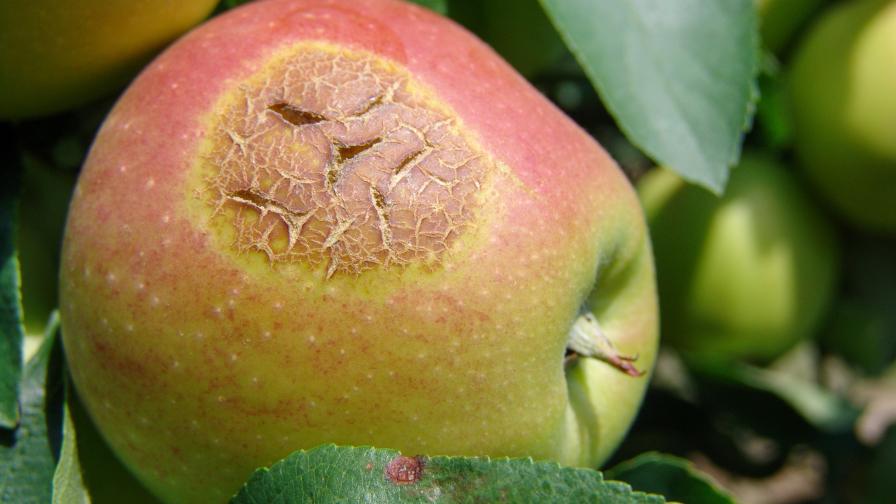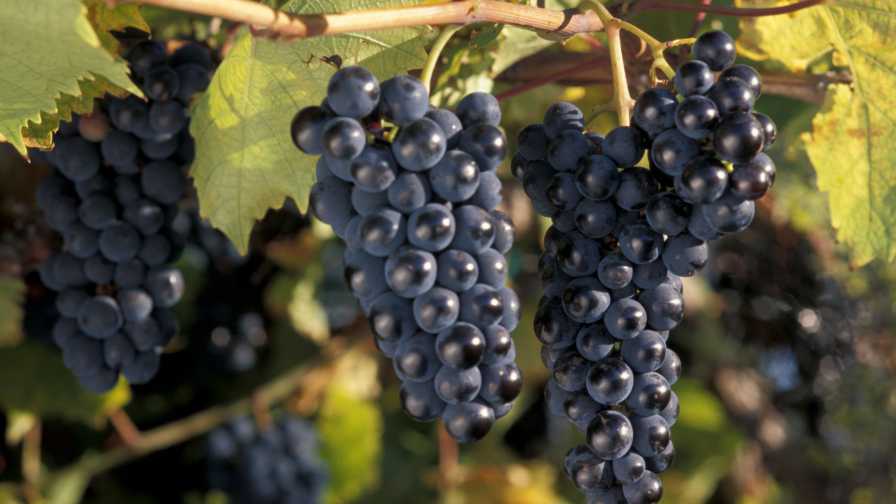Stay In Sync To Protect Your Apples From Sunburn

Methods to reduce apple sunburn include netting, evaporative cooling, fogging, reflective materials, and combining any of these strategies.
Photo by Gerald Holmes
Apple growers can approach sunburn management — relevant in the wake of last year’s heat dome in the Pacific Northwest (PNW) — in a variety of ways, according to Lee Kalcsits, a Professor of Tree Fruit Physiology at Washington State University (WSU).
Long-term solutions refer to tactics, such as netting and evaporative cooling, that need to be installed in previous seasons, either at planting or by retrofitting. Short-term management involves reactive strategies, including reflective sprays, kaolin clay, and running sprinkler systems differently.
Kalcsits was one of a dozen researchers and growers who spoke at the “Feeling the Heat” symposium, presented by the Okanagan Horticulture Advisor’s Group and BC Fruit Growers’ Association. The seminar addressed the effects of the 2021 summer heat event on tree fruit in the PNW.
Sunburn: Causes and Types
Two main factors — incoming light and heat — create apple sunburn, Kalcsits says. Lesser impacts include wind speed, relative humidity, smoke cover, and diffuse vs. direct light.
“When you have high light, the difference between the air temperature and the fruit surface temperature is going to be much larger than if there is low light conditions, where the fruit surface temperature is going to be much closer to the actual air temperature itself,” Kalcsits says. “So, you get the air temperature that brings up the base level, and then you have light intensity that contributes to the difference between the fruit surface temperate and the air temperature.”
Growers experience sunburn browning most frequently. Cell death on the outer peel has not yet occurred, but there is damage. “Kind of how your skin gets a sunburn in the summertime if you’ve been out too long,” Kalcsits says.
Far worse is sunburn necrosis, which is purely heat driven. Growers suffered this fate during the heat dome, when fruit surface temperatures exceeded the threshold of 120° to 125° F. “As soon as it exceeds that, you essentially get a cooking of the fruit, or cell death, and end up with necrotic tissue that will either lead to the fruit falling off, or it’s just not harvestable,” Kalcsits says.
A third type of apple sunburn — photooxidative — can occur when the fruit moves as its branch grows, potentially from shaded conditions to full light conditions. Summer pruning and leaf removal can have the same effect.
“The fruit surface is used to shade conditions, and then it gets overwhelmed when it gets exposed to sudden light,” Kalcsits says. “You get photooxidative sunburn. There’s a bleaching effect on the bottom.”
Production Issues
High-density fruiting walls, with little leaf area, can exacerbate the sunburn situation, Kalcsits says.
“We’re exposing those fruit to full-light conditions because we want to maximize yield, and we want to maximize proper fruit color development,” Kalcsits says. “There’s a trade-off there. It increases sunburn risk because all that fruit is exposed. It has nowhere to hide when it gets hot.”
Other factors include ground cover and canopy. Orchards with ground cover that is green have been found to be cooler than bare ground or dried grass. Kalcsits saw this last year while conducting deficit irrigation treatments that used drip irrigation in favor of micro-sprinklers. The middles between those rows were very dry.
“The fruit surface temperatures were much higher, and also the air temperature within that orchard was much higher,” Kalcsits says. “When you’re talking about air temperatures setting the base of that fruit surface model, if you can cool down your orchard through maintaining a more green ground cover, it will help reduce that base temperature and reduce sunburn risk overall. We saw that consistently during that heat dome event while traveling to different orchards across state. The orchards that were doing the best had some sort of grass ground cover in-between.”
Meanwhile, rootstocks with more vigor and leaf area will fare better in sunburn conditions. “The training system matters,” Kalcsits says.
Long-Term Strategies
Kalcsits and fellow WSU Professor Kirti Rajagopalan have studied the effects of netting while comparing differing shade percentages and colors. Netting is very effective, Kalcsits says, citing 20% to 30% reductions in incoming light, according to Rajagopalan’s research. However, netting, while lowering fruit surface temperatures, does not reduce air temperatures.
“Last year when air temperatures reached 115°F, it was already at the threshold for sunburn to happen,” Kalcsits says. “So even reducing by 20% just isn’t enough in a year like this. But in a normal year, where the temperatures are 105°F, and there’s maybe a little bit of wind, netting would be effective on its own.”
Evaporative cooling, when properly cycled on and off, can substantially reduce sunburn by cooling the fruit, Kalcsits says. If the on cycle is not maintained long enough — around 10 to 20 minutes, Kalcsits says — the application will not be wet enough to have a cooling effect. And if the off cycle lasts too long, the fruit will fully dry, allowing the surface temperature to rapidly increase.
“You need to make sure your cycling strategy is in sync with the evaporative demand or how quickly the canopy will dry out,” Kalcsits says. “If you have it in sync, it’s very effective in reducing fruit surface temperatures and orchard air temperatures as well.”
Fogging systems, while left on continuously to apply a fine mist over the tops of trees, use much lower volumes of water — up to 5 gallons per acre per minute — than evaporative cooling, Kalcsits says.
“In general, these don’t get the soil wet like evaporative cooling does,” Kalcsits says. “As soon as these turn off, the orchard is essentially dry. It’s maybe a little bit damp, but it’s not soaking wet, it’s not dripping, if being run properly.”
Short-Term Solutions
Reflective materials, such as kaolin clay, rely on increasing the reflectivity of the fruit by spraying a white spray on it to reflect incoming radiation. Unfortunately, as with netting, if the air temperature is approaching the threshold for sunburn to occur, the strategy will not be fully effective, Kalcsits says, unless the grower makes the application completely white, which, in turn, is difficult to clean off.
The most successful strategy to combat the heat dome involved stacking — i.e., combining netting and evaporative cooling or netting and fogging.
“We found these were the best because you get the consistent benefit of reducing incoming radiation while having the ability to cool further if needed,” Kalcsits says.










